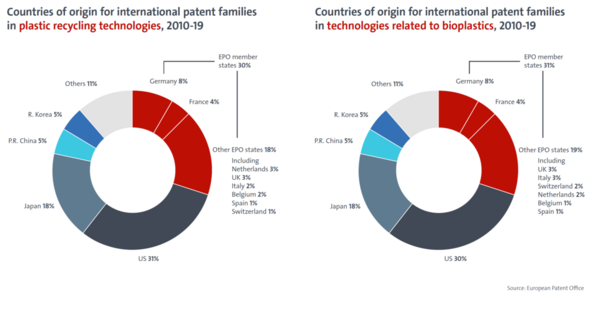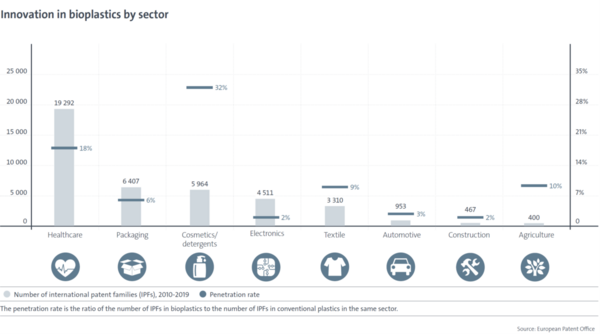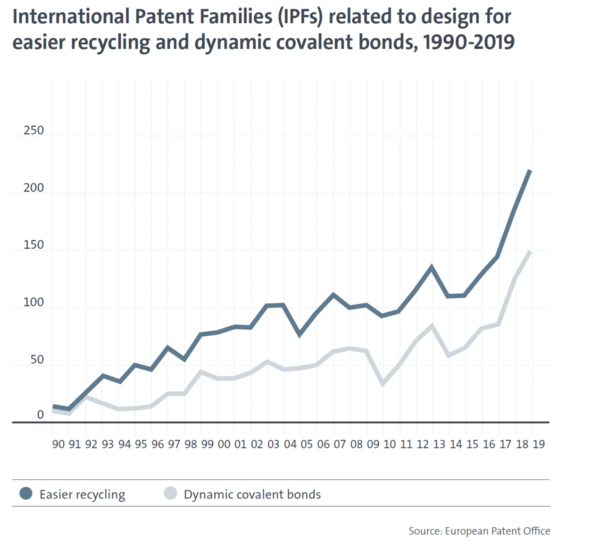From a global perspective, Europe and the US are leading innovation in plastic recycling and alternative plastics technologies, a new study published today by the European Patent Office (EPO) shows. Europe and the US each accounted for 30% of patenting activity worldwide in these sectors between 2010 and 2019, or 60% combined. Within Europe, Germany posted the highest share of patent activity in both plastic recycling and bioplastic technologies (8% of global total), while France, the UK, Italy, the Netherlands and Belgium stand out for their higher specialisation in these fields.


Study
Europe and US are leading innovation in plastic recycling and alternative plastics globally, patent data shows
- European Patent Office (EPO) study reveals that Europe and US together account for 60% of patenting activity worldwide related to plastic recycling and bioplastic technologies
- Of all recycling technologies, chemical and biological methods generated highest level of patenting activity
- Healthcare, cosmetics and detergent industries are at the forefront of innovation in bioplastics
- EPO President António Campinos: “This report highlights Europe’s contribution towards a circular economy for plastics, but shows more can be done to transfer fundamental research to industry.”

Titled Patents for tomorrow’s plastics: Global innovation trends in recycling, circular design and alternative sources, the study presents a comprehensive analysis of the innovation trends for the period 2010 to 2019 that are driving the transition to a circular economy for plastics. The report looks at the number of international patent families (IPFs), each of which represents an invention for which patent applications have been filed at two or more patent offices worldwide (so-called high-value inventions). It aims to provide a guide for business leaders and policymakers to direct resources towards promising technologies, to assess their comparative advantage at different stages of the value chain, and to highlight innovative companies and institutions that could contribute to long-term sustainable growth.
“While plastics are essential to the economy, plastic pollution is threatening ecosystems all over the planet,” said EPO President António Campinos. “The good news is that innovation can help us to address this challenge by enabling the transition to a fully circular model. This study offers key insights into a range of promising new technologies that foster the reusability, recyclability and bio-degradability of plastic products. It highlights Europe’s contribution to innovation in this sector, but shows that much more can be done to turn pioneering European research into inventions and to bring them to market.”
Chemical and biological recycling methods with highest number of patents
The study highlights that of all recycling technologies, the fields of chemical and biological recycling methods generated the highest level of patenting activity in the period under review. These methods accounted for 9 000 IPFs in 2010-19, double the number filed for mechanical recycling (4 500 IPFs), which is currently the most commonly used solution to transform plastic waste into new products. While the patenting of standard chemical methods (such as cracking and pyrolysis) reached a peak in 2014, emerging technologies such as biological methods using living organisms (1 500 IPFs) or plastic-to-monomer recycling (2 300 IPFs) now offer new possibilities to degrade polymers and produce virgin-like plastics.
Untapped potential to commercialise European university research
The report also finds that in the chemical and biological recycling fields, fundamental research plays a much more significant role than in other plastic recycling technologies, with nearly 20% of inventions originating from universities and public research organisations (see Figure: Fundamental research in recycling technologies, 2010-19). In terms of geographic location of these universities and public research organisations, Europe and the US have a clear lead, each with 29% of those IPFs stemming from research institutions. The report shows that Europe is the only major innovation hub to contribute a larger share of the chemical and biological recycling inventions from fundamental “upstream” research (29%) than overall in the field (26%). By contrast, the US and Japan’s contributions to upstream IPFs (29% and 11%) are lower than their respective shares in all IPFs (36% and 17%). Meanwhile, US start-ups and scale-ups generated four times as many IPFs in chemical and biological recycling as their European counterparts (338 v. 84). This suggests that Europe, despite being particularly active in fundamental research, is not exploiting its full potential when it comes to transferring these technologies to industry.
Healthcare and cosmetics & detergent industries lead in bioplastic innovation
In the area of bioplastic inventions, the study finds that the healthcare sector has by far the most patenting activity in total (more than 19 000 IPFs in 2010-19), despite accounting for less than 3% of the total demand for plastics in Europe. However, the cosmetics and detergents sector has the largest share of its patenting activity in bioplastics, with the ratio of bioplastics IPFs to conventional plastics IPFs being 1:3, compared to 1:5 in the healthcare sector. Packaging, electronics and textiles are also significant contributors to innovation in bioplastics.

Rapid rise in innovation in plastics that are easier to recycle
Looking ahead, the study highlights significant potential in new plastic designs for easier recycling, an area of alternative plastics which has developed exponentially in recent years, with an average annual growth rate of 10% since 2010. These technologies have potential applications in aerospace, construction, transportation, wind turbines and microelectronics. The rapid growth of patenting in these fields is almost entirely driven by innovation in dynamic covalent bonding – an approach allowing for novel designs of durable plastic materials capable of self-repairing. While Japan has a strong lead in this field, most of the inventions coming from universities and public research organisations in this field originate from European and US research institutions.

The comPETence center provides your organisation with a dynamic, cost effective way to promote your products and services.

magazine
Find our premium articles, interviews, reports and more
in 3 issues in 2026.



